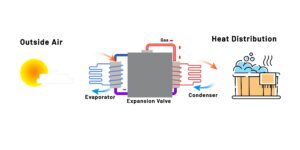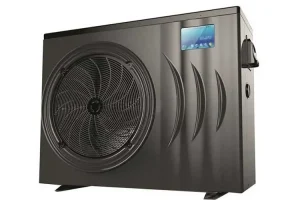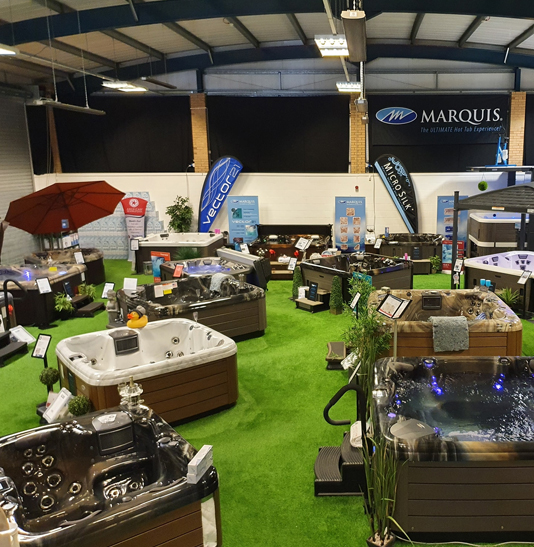If you’ve been wondering if adding an Air Source Heat Pump to your spa is a good idea, then read on, as we look at the pros and cons (if there even are any) of ASHPs.
An Air Source Heat Pump can work with almost all new and existing hot tubs, which means they are perfect, whether you are looking at venturing into the world of hot tubs or if you are a seasoned pro and are looking to reduce your energy costs and carbon footprint. Heat Pumps will use far less energy than a standard electric heater that you’ll find in a hot tub, which in turn means you’ll be reducing your carbon footprint. Heat Pumps, although relatively new to the hot tub industry, have been used for years in other sectors and are very similar to an air conditioning unit, which is proven technology, reliable and low maintenance.
So, how does an Air Source Heat Pump actually work?
So they are not a new concept, but you may only just be hearing about them now energy prices are rising and people are looking for new ways to reduce their bills. They are based on refriderator technology which was first invented back in 1755, so the fails have already happened!
An Air Source Heat Pump works by extracting heat from the outside ambient air, then transfering it into the water in the hot tub.
- Outside air is drawn over the evaporator which contains cold refridgerant gas, because the gas is colder that the ambient air, heat from the air is transferred into the colder body of gas.
- This slightly warmed gas is then pumped through a compressor, which increases the temperature of the gas.
- The hot gas is then drawn through a condenser/heat exchanger which transfers the heat into the hot tub water.
- The gas is then passed through an expansion valve, releasing the pressure and cooling it down, ready to start the cycle again.
The saving is made because the only electricity used is to power the process. It doesn’t heat the water, unlike the conventional electric heater in the spa does, meaning that more heat can be created for the same amount of power, leading to faster heat up times and reduced electrical draw.
Lets talk efficiency
The main performance figure of an air source heat pump is the COP, Coefficient of performance. This simply means the ratio of electricity used, to heat outut produced. For example, a heat pump with a COP of 5, means that for every 1kw of heat used, 5kw of heat is produced.
So, in money terms, lets say a unit of electricity costs 34p per kw/h. Using the internal heater to produce 5kw of heat it would cost £1.70. An Air Source heat Pump would cost just 34p to produce the same amount of heat.
Our Air Source Heat Pumps can operate in temperatures down to -25c and under UK temperatures of 15c offer an average COP of 6, reaching up to almost 15 in peak conditions.
But…..its not quite that simple really! The output of an ASHP is dependant on a number of variables, including water temperature, outside temperature and also humidity. You might find an ASHP with amazing COP during peak conditions, but the COP will drop in the winter when the ambient temperature is less, so check the range of COP when choosing the right ASHP for your spa and climate, not just the one that offers the best at high air temperature.
Another factor is the tehnology used within the heat pump, including the hardware and the refridgerant gas. Modern heat pumps use R32 gas which is usually more effective at lower temperatures, vitally important in our UK climate. The other main component is the compressor used, on/off or invertor.
So should I choose On/Off or Inverter Technology?
On/Off? These compressors are either on, or they’re off, so its all or nothing. The don’t vary their output. An invertor style ASHP will run at variable speeds, so on a summer day, they’ll run more slowly therefore using less power.
Invertor? Invertor technology will vary in speed, meaning the equipment will only run when required, therefore much more efficient and cost saving. They are also typically quieter that on/off ASHPs.
To simplify…
An Air Source Heat Pump will remove the requirement for the electric heater in your spa and use the outside air temperature (even down to minus 25c) to heat your spa. The ASHP will create lots of free heat, meaning fast heat up times (as little as 3 hours from cold) and cheaper bills (as much as 85% less compared to using an electric heater).
Advantages
Low running costs!
Eco-Friendly!
Super Quiet!
Versatile – heat and cool!
Low Maintenance
Disadvantages
We can’t think of a single one…..
F.A.Q
How much do they cost?
Our range of ASHPs start from £649 for a 3kw On/Off and £1490 for a 5kw Invertor model. We also have commercial grade ASHPs ranging from 12 – 21kw, perfect for holiday park hot tubs where super fast heat up times are required and where the maximum savings will be gained. Installation varies depending on spa and location.
What is the maintenance like on an ASHP?
We recommend an annual service at the same time as your spa service, which will be included in the usual cost of the service
How noisy are they?
Some models can be quite loud, but we have opted to fit almost silent models running at less than 30db. Your usual fridge runs at around 50db for comparison.
Can I fit one to my existing spa?
Our ASHPs will fit to 99% of spas, we just need to consider whether there is sufficient access to the plumbing and also the circulation flow rates.
How much space do I need?
Some ASHPs require a lot of air flow around them, but some can fit right next to the spa. If you would like us to take a look, please send a picture of your spa to info@1stopspas.com and we will advise the best placement for your ASHP.









